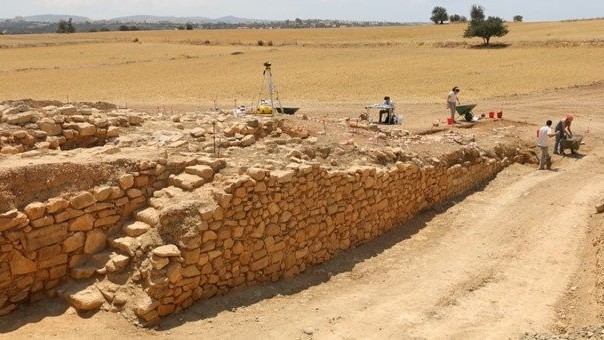
In Cyprus, archaeologists have discovered an ancient fortress under a burial mound that dates back to the early fifth century B.C..
Over the past ten years, researchers have been steadily excavating and digitally recording the tumulus. However, according to a recent discovery, the tumulus was built on top of a crumbling rampart that dates to the early fifth century B.C., making it even older than the mound.
The 328-foot-long by-196-foot-wide (100 by 60-meter) tumulus of Laona was presumably constructed in the third century B.C. when Alexander the Great’s successors were battling for control of Cyprus and a sizable portion of the Empire.
About 484,000 cubic feet (13,700 cubic meters) of loose dirt with sand, silt, or clay, known as marl, and red soil, which had been imported from other parts of Cyprus for the construction of the tumulus, was used by ancient Cypriots to bury the fortress wall.
According to the University of Cyprus Department of Antiquities, the Laona fortification was quite well preserved beneath the tumulus; its northeast corner survives to a height of twenty feet (six meters), making it one of the most important monuments of the “Age of the Cypriot Kingdoms.”
The Department of Antiquities in Cyprus revealed in a statement issued on August 13th on Facebook that “Laona combines two monuments that are so far unique in the archeology of Cyprus” with the “unexpected discovery” of the damaged rampart beneath the “lasting mega-monument.”
Giorgos Papantoniou, a Trinity College Dublin assistant professor of ancient visual and material culture who wasn’t part of the excavation, stated that “the mound was always visible, but the locals considered it a natural hillock. Its geological identification as an artificial mound was confirmed in 2011.” The tumulus is located 0.6 miles (one kilometer) northeast of the Sanctuary of Aphrodite, an ancient site dating to the 12th century B.C..
In a 2021 article published in the journal Geoarchaeology, researchers described the tumulus as “an accomplished architectural structure” that was built over time in several stages.
“As the height of the structure gradually increased, the tumulus became an imposing physical mark that gave the landscape a new meaning,” researchers said.
Ancient Fortress in Cyprus Attributed to Royal Family
The royal family that controlled Paphos to the end of the fourth century B.C. is recognized for building the recently discovered rampart, which is Cypro-Classical in style. The palace and workshop complexes on the citadel of Hadjiabdoulla, which are located approximately 230 feet (seventy meters) from Laona are functionally comparable to the same period as the wall, according to archeologists.
Papantoniou told Live Science in an email that the discovery is a part of broader research whose “main goal is the identification of the urban structure of the capital center of the ancient polity of Paphos.”
The antiquities team recently conducted an excavation that revealed the east side of the rampart as well as two old staircases. The rampart shifted north under the tallest point of the mound, according to an additional study.
In a statement posted on Facebook, the team reported that “its wall follows a descending [northwest] course, and it is in an excellent state of preservation.”
According to investigations near the wall’s base, the project was likely begun by ancient people leveling the land. The assertion claims that a thick layer of river pebbles and a layer of red dirt containing sherds, or shattered fragments of pottery, are on top of this leveled land. It is unknown who was responsible for erecting the monument.
For the time being, further excavation of some of the rampart’s features, such as the northern staircase, has been put on hold out of safety concerns. The Laona Project will now concentrate on the tumulus.
Experts claimed that the large burial mound’s construction would have required a sizable and skilled staff led by knowledgeable engineers. Further investigation at Laona will look for evidence that the structure is a burial mound and try to determine who built it.
See all the latest news from Greece and the world at Greekreporter.com. Contact our newsroom to report an update or send your story, photos and videos. Follow GR on Google News and subscribe here to our daily email!



